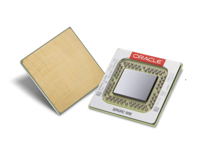Though Oracle has laid off many of its Solaris and SPARC employees, the company is continuing to push forward with new developments. On Sept. 18th, Oracle announced its M8 SPARC silicon platform, re-committing to the the RISC-based platform it gained via the acquisition of Sun Microsystems.
The M8 is a 32-core chip that supports up to 256 threads and 64 MB of L3 cache, and it includes a number of operation-specific capabilities. The on-chip Data Analytics Accelerator (DAX) executes real-time data decompression.
of operation-specific capabilities. The on-chip Data Analytics Accelerator (DAX) executes real-time data decompression.
The In-Memory Query Acceleration feature on the SPARC M8 also helps to improve performance for data-intensive tasks. For Oracle database, the M8 includes a feature called Oracle Numbers that helps to accelerate arithmetic operations.
Security is also a key focus of the M8 thanks to the new Silicon Secured Memory capability, which provides data integrity analysis to protect against potential malware. Additionally, the M8 benefits from cryptographic acceleration capabilities.
“Oracle has long been a pioneer in engineering software and hardware together to secure high-performance infrastructure for any workload of any size,” Edward Screven, chief corporate architect at Oracle, stated. “SPARC was already the fastest, most secure processor in the world for running Oracle Database and Java. SPARC M8 extends that lead even further.”
The SPARC M8 silicon is powering a new line of SPARC servers that includes the SPARC M8-8. The M8-8 is powered by 8 M8 chips running at 5.0 GHz.
The new SuperCluster M8 is the SPARC version of Oracle’s Exa-class engineered systems, integrating Oracle Database software with hardware. The SuperCluster M8 is powered by up to 4 M8 processors running at 4.1 GHz.
Oracle’s T-series is also getting an M8 SPARC makeover with the new T8-4, T8-2 and T8-1 servers. The SPARC T8 servers are positioned by Oracle for enterprise workloads running Oracle applications.
Sean Michael Kerner is a senior editor at ServerWatch and InternetNews.com. Follow him on Twitter @TechJournalist.

